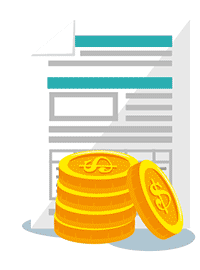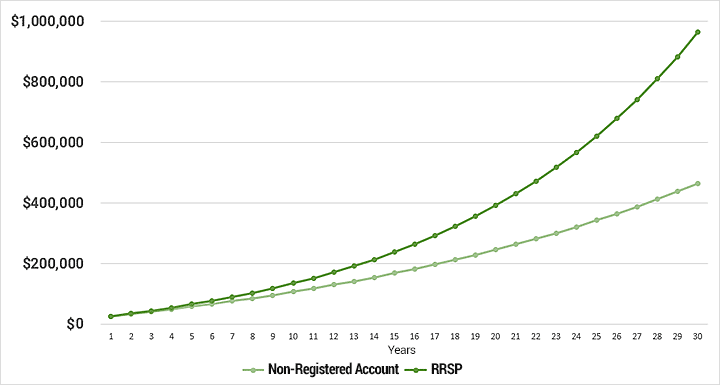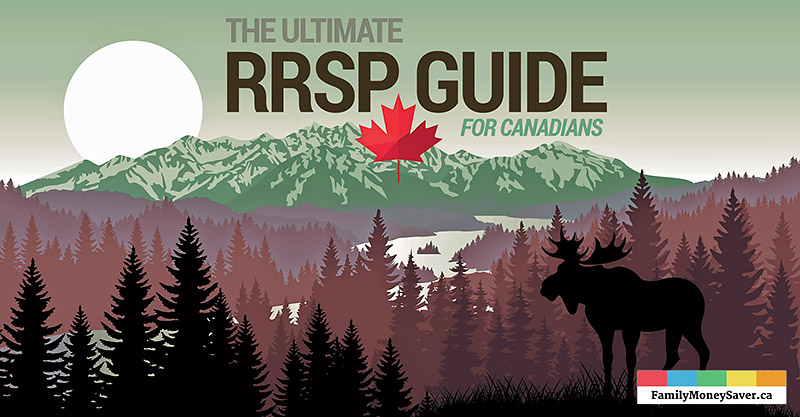Introduction
What is an RRSP?

A Registered Retirement Savings Plan (or RRSP) is a retirement savings plan that is registered with the Government of Canada through the Canada Revenue Agency (CRA). The purpose of this type of account is to allow you and your spouse, or common-law partner, to save more effectively for retirement utilizing several benefits. Mainly, that contributions to your RRSP can be used to reduce your income tax and provide a tax shelter as your investments grow. More on that later!
RRSP Basics

Why would you open an RRSP? RRSP contributions are tax-sheltered from interest, dividends and capital gains taxes. This is advantageous because it allows your investments to grow tax-free while inside your RRSP.
Who can open an RRSP? Anyone who has earned income and filed a tax return in Canada can open a Registered Retirement Savings Plan. You can contribute to your RRSP until December 31 of the year that you turn 71 as long as you still have contribution room.
Your RRSP has a contribution limit every year, and it’s the maximum amount you can put in your account per tax year (excluding unused contribution room). The total contribution amount is based on 18% of your previous year’s income up to a maximum of $27,230 (2020).
Example Scenario:
Note – Your contribution limit may be less if you have a pension through your employer.
The simplest way to find your contribution limit is to check the RRSP statement that accompanies your “Notice of Assessment” after you file your taxes each year. This document will provide the calculation and the amount for you.
Contribution Room

Your total contribution room will grow every year you earn income. Any unused contribution room can be taken advantage of in subsequent years, allowing you to contribute more than the maximum accumulated for a particular year. This unused room can be beneficial if you suddenly receive a large lump sum of money, such as an inheritance, monetary gift, lottery winnings etc.
If you’re curious about your limit, the Canada Revenue Agency tracks RRSP room, deductions and your unused contribution room. The CRA sends this information to you every year on your RRSP statement. (Form T1028, Your RRSP Information for 2020)
Example Scenario:
 Jennifer started working two years ago after finishing school and would like to save for retirement. She earned $50,000 in 2019 and $50,000 in 2020. She will have accumulated $9,000 in contribution room each year, for a total of $18,000. If she makes an RRSP contribution of $5,000 in 2019 and $3,000 in 2020, she will have $10,000 of unused contribution room.
Jennifer started working two years ago after finishing school and would like to save for retirement. She earned $50,000 in 2019 and $50,000 in 2020. She will have accumulated $9,000 in contribution room each year, for a total of $18,000. If she makes an RRSP contribution of $5,000 in 2019 and $3,000 in 2020, she will have $10,000 of unused contribution room.
| Jennifer's Contribution Room | $18,000 |
|---|---|
| 2019 RRSP Contribution | $5,000 |
| 2020 RRSP Contribution | $3,000 |
| Jennifer's Unused RRSP Contribution Room | $10,000 |
Withdrawals / Withholding Tax

| Withdrawal Amount | Withholding Tax Rate |
|---|---|
| up to $5,000 | 10% |
| between $5,001 and $15,000 | 20% |
| over $15,000 | 30% |
Note – Tax rates apply to all provinces except Quebec, where provincial tax rates apply on top of federal withholding tax.
So if you were to take out $25,000 from your RRSP, you would immediately be charged withholding tax of $7,500 (30%). You are essentially being charged taxes upfront and will pay the difference upon filing your income tax or receive a refund for the difference.
Example Scenario:
 Henry is semi-retired and withdraws $25,000 from his RRSP, and his financial institution must deduct the withholding tax of $7,500. He made an additional $18,000 of income this year and filed his tax return for a total of $43,000. He is in the 20% marginal tax bracket, so he only owed $3,800 on the $25,000 he withdrew from his RRSP. The tax Henry owes will be reduced by the overpayment of $3,700, as he originally paid 30% in withholding taxes.
Henry is semi-retired and withdraws $25,000 from his RRSP, and his financial institution must deduct the withholding tax of $7,500. He made an additional $18,000 of income this year and filed his tax return for a total of $43,000. He is in the 20% marginal tax bracket, so he only owed $3,800 on the $25,000 he withdrew from his RRSP. The tax Henry owes will be reduced by the overpayment of $3,700, as he originally paid 30% in withholding taxes.| At the Time of Withdrawal | |
|---|---|
| Henry Withdraws | $25,000 |
| Withholding Tax (30%) | $7,500 |
| Henry's Net Withdrawal | $17,500 |
| After Tax Return Assessment | |
|---|---|
| Henry Paid in Withholding Tax | $7,500 |
| Henry Actually Owed in Taxes | $3,800 |
| Henry's Overpayment (goes back to him) | $3,700 |
Note – If you have a high income and are in a tax-bracket above the 30% withholding tax rate, you will owe the Government the difference in taxes when you file your return.
RRSP Deadline
Every year there is a deadline date, typically 60 days after the end of the year, which is the final day you can make an RRSP contribution for the previous tax year. The deadline to make your 2020 RRSP contribution is March 1, 2021.
Opening Your RRSP
How Do I Open an RRSP?
A common misconception overhead is people talking about “buying” an RRSP when in fact an RRSP is a registered “account” you set up. Don’t be intimidated by unfamiliar terms or acronyms. Your financial institution, bank, credit union or trust company can help you get set up. Just ask!
Types of RRSPs
First off, there are different types of RRSPs you might want to investigate or learn about, for example, Individual RRSPs, Spousal RRSPs, and Group RRSPs. You can discuss options and ask questions at your bank or financial institution and see what sort of options they offer and what sort of fees they charge on investments and account management.
How Can I Invest in My RRSP?
A recent survey by a major Canadian bank survey found that 50% of Canadians didn’t know what type of investments you can hold in your RRSP. Your RRSP can contain many different types of investments depending on the type of account you open. Some accounts will only let you invest in specific products such as GIC’s or Mutual Funds. You can, however, set up a self-directed RRSP if you want to manage your own portfolio. Doing this will allow you to invest in a broad range of qualified investments.
Required Documents
When you go to your financial institution to open the account, you will likely need two pieces of ID (one government-issued). Identification will be necessary to open a registered account (unless your institution already has this on file) – verify this with them beforehand. You will also need to provide other information such as if you have a pension plan at work. To help determine your contribution limits, you can find your Notice of Assessment from the Canada Revenue Agency or sign up for CRA My Account for Individuals. Many institutions will let you fill out an application online now as well. Finally, you will need to consider designating a beneficiary for whom your money will go in case of death.
Investor Profile
Suppose you are using your RRSP to invest in something besides basic savings or term deposits. In this case, you will be asked several questions about your investment goals, time horizon, risk tolerance and your level of investment knowledge and finances. Your bank or financial institution should use this information to help advise you on what may be the most appropriate investments for your RRSP, along with how much and how often you can afford to contribute.
Funding Your RRSP
When you open your RRSP, you will most likely have to deposit some money to “fund” the account. You can deposit a lump sum, but it also may be an excellent time to consider setting up an automatic savings plan. Recall, this is a smart option by introducing forced savings and avoiding not having enough money saved to contribute before the annual RRSP deadline each year! If you open a self-directed RRSP, you can deposit funds and leave them parked as cash or as savings and take time to decide how you would like to invest your money.
Transferring Your RRSP
If you’re transferring an existing RRSP from another financial institution, there may be a fee to do so. Many institutions receiving the new RRSP funds will offer to cover the fee but will generally have a minimum transfer amount required. The reason RRSPs are transferred directly between financial institutions is to maintain the tax-free status.
RRSP Strategies
Contribute Early & Often
Many will wait until the end of the year to contribute to their RRSP. This can be a poor strategy, as many of us spend throughout the year only to find there is nothing left for our retirement savings. Therefore, it is highly encouraged to make regular contributions throughout the year or set up an automatic savings plan.
You can do this easily through your financial institution, as many let you enroll in automated savings programs that will transfer money to your RRSP every paycheque. These forced savings strategies have many benefits and will keep you on track with your retirement goals.
RRSP Loans
If you can’t afford to make your planned contribution for some reason, there are still options. RRSP Loans or lines of credit can be beneficial as they allow you to contribute to your RRSP and realize the tax savings.
In most cases, with an RRSP loan, you are borrowing to invest. You might be much better off paying off high-interest debt. Whether this is a prudent financial strategy can be quite complicated and will depend on a wide variety of factors with regards to your own personal situation.
Here is a more in-depth look at whether it makes sense to take out an RRSP Loan. It would be prudent to discuss this option with a qualified financial advisor who is familiar with your situation.
Common Misconceptions
Not Just a Savings Account

Your RRSP can be a basic savings account, but you can also purchase eligible investments such as stocks, bonds, mutual funds, GIC’s, ETF’s, REITs and more. Investing in options with potentially higher-returns is where tax-sheltering your money can really help your savings grow at a faster pace via higher returns and the magic of compounding.
It makes perfect sense to include tax-sheltered accounts like your RRSP as part of your long-term savings plan.
You Can Withdraw Money at Any Time
Another common misconception is that your money is locked in the account until retirement age with an RRSP. Your RRSP works most efficiently when the contributions are invested over the long term. However, some worry they won’t be able to access their savings in case of an emergency. This false understanding can be a deterrent to many Canadians from investing in their RRSP in the first place.
The truth is, in most cases, you can withdraw money from your RRSP at any time! If you do have an emergency or some other reason you need the money, it is possible in most cases to access some of it immediately.
While withdrawing your funds at any time is an available option, keep in mind that it’s not a great idea. You should access other savings or funds first, if possible, so you don’t negatively affect your compound growth. You may also be withdrawing while in a higher tax bracket, which is a negative. You also need to keep withholding tax in mind, as you will not get all of your funds immediately. Sometimes a loan is the better option.
So while it is a myth that you can’t access your RRSP until retirement, it is generally not advisable to do so if you can avoid it.
Note: Funds in a non-redeemable fixed term investment or that originated from a Pension Plan, may have withdrawal restrictions.
Spousal or Common-Law Partner RRSP

You may benefit from income-splitting between spouses, when taking out the money. Your retirement income may be taxed at a lower rate. This may allow the higher earner to possibly pay less tax and maybe avoid some Old Age Security (OAS) clawback.
Another benefit is being able to contribute based on the higher earners’ deduction room, as the lower-income earner may have less RRSP room. Creating future income for the low-income earner by growing your RRSP over time could present further perks. For example, RRIF or annuity income created from an RRSP at age 65 also qualifies for the pension income tax credit, which can be a benefit if you don’t have a qualifying income for this tax credit.
SPOUSAL WITHDRAWALS
There are also special rules regarding withdrawals from spousal RRSPs. With a spousal plan, the person making the contributions and receiving the tax deductions is called the “Contributor“. The other is the plan owner of the RRSP, or “Annuitant“.
You have to be cautious with the timing of your withdrawals, as the Spousal RRSP has a “3-year attribution rule“, which relates to how withdrawals are taxed.
Suppose a taxpayer has contributed to any spousal plan in the year of withdrawal or either of the two preceding years. In that case, the lesser of the funds withdrawn or the amount contributed during this period will be taxed to the Contributor. If the amount withdrawn is more than the amount contributed during the 3-year period to any plan, the “excess” is taxable to the Annuitant/plan owner.
The attribution rule terminates upon the death or non-residency from Canada or upon the spouses’ or common-law partners legal separation or divorce.
Deferring RRSP Deductions
An often overlooked or unknown advantage to a Registered Retirement Savings Plan is that you don’t have to take the deduction at the time you contribute.
There are situations that may arise where you have some money to contribute to your retirement savings, but it’s not an advantageous time to take the tax deduction. For example if you are earning a low wage or in a low tax bracket, but expect to earn more a few years down the road, it may make sense to defer the deduction to a future year.
You want to take the deductions in your highest earning years if possible, to reduce your taxable income and your overall tax bill as much as possible.
Example Scenario:
 Marit is a graduate student who is working part-time and earning roughly $28,000/year. She happened to receive an inheritance recently and has RRSP contribution room that she would like to use. Marit expects that when she is finished her degree next year she will be earning close to a six-figure income. In a case like this, it would make sense for her to make an RRSP contribution now and give her money the most time possible to grow. Once she begins her career and is earning more, she can utilize her deductions from previous RRSP contributions to reduce her now higher net income, thus lowering the amount of tax she has to pay.
Marit is a graduate student who is working part-time and earning roughly $28,000/year. She happened to receive an inheritance recently and has RRSP contribution room that she would like to use. Marit expects that when she is finished her degree next year she will be earning close to a six-figure income. In a case like this, it would make sense for her to make an RRSP contribution now and give her money the most time possible to grow. Once she begins her career and is earning more, she can utilize her deductions from previous RRSP contributions to reduce her now higher net income, thus lowering the amount of tax she has to pay.RRSP Mistakes to Avoid
Overcontributing
As we discussed already, your RRSP will have an annual contribution limit and total contribution room. Exceeding your limit or “over-contributing” can result in tax penalties in most cases of 1% per month that you are over the limit.
The CRA provides a small cushion of $2,000 for which you will not be charged a penalty on. However, those funds will not be considered tax-deductible.
You can read more about what happens if you go over your RRSP deduction limit on the CRA website.
Early Withdrawal
Withdrawing funds from your RRSP if you don’t really need to, can sabotage your money’s growth. The magic of compound interest combined with tax-sheltering will pay dividends in the future. Therefore, it is best to avoid early withdrawals if possible.
Not only will you lose time compounding your money, but you will also have to report these withdrawals as income. This will increase your income, potentially putting you in a higher tax bracket, and may also be a poor decision if you are already in a high tax bracket as you will be withdrawing money at a higher cost potentially than in your retirement years.
Another downside to early withdrawal, is that you will lose your contribution room. Unlike the Tax-Free Savings Account (TFSA), your contribution room is not re-instated the next year after withdrawals. Once you withdraw money from your RRSP, you lose that contribution room forever in most cases.
Pros and Cons of RRSPs
RRSP Advantages
Lower your Income Tax
RRSP contributions are deducted from your income. This lowers your net income and, therefore, the amount of income tax you pay. Most people who contribute will generally get a tax refund as a result of their contribution. The more you contribute, the lower your income tax and the larger your refund may be.
Qualify for Government Benefits
By making RRSP contributions and lowering your net income, you may qualify for larger amounts when it comes to government benefits, for example, the Canada child benefit (CCB). Or, you may even be able to bring your income down enough to receive benefits you normally wouldn’t qualify for. You can discuss benefits and contribution strategies with your financial advisor or a professional accountant.
Withdraw Savings in a Lower Tax Bracket
One of the significant advantages of an RRSP is that you may be able to withdraw funds during your retirement years when you are in a lower tax bracket. This can be particularly beneficial for high-income earners.
Canada has a progressive (or graduated) tax system, which means that higher-income earners will pay a higher tax rate on those earnings than lower-income earners. So how does this relate to RRSPs?
During your high earning years, you can contribute money to your RRSP, lowering your tax bill and potentially receiving more government benefits. When you stop working, you may be in a lower tax bracket as you may be drawing less income than you earned during your working years.
Example Scenario:

Richard wants to be in a lower marginal tax bracket, so Richard contributes $16,000 to his RRSP. He receives a tax deduction by contributing, and his marginal tax rate is reduced to 31%. Richard will now only pay $23,000 in taxes, a savings of about $6,000. This brings his total after-tax income to $82,000.
Scenario 1 (No RRSP Contribution)
| Richard's Employment Income | $105,000 |
|---|---|
| RRSP Contribution | $0 |
| Richard's Income Tax Owing | $29,000 |
| Richard's After-Tax Income | $76,000 |
Scenario 2 (RRSP Contribution)
| Richard's Employment Income | $105,000 |
|---|---|
| RRSP Contribution | $16,000 |
| Richard's Income Tax Owing | $23,000 |
| Richard's After-Tax Income | $82,000 |
Note: Examples are rounded (estimated) numbers and simplified for illustration purposes due to unknown factors, including the province of residence, CPP/EI, government clawbacks etc.
Tax Brackets in Canada
See the tables below for a brief example of tax brackets in Canada and how they work. Tax rates in Canada vary according to the total amount of income you earn and there are different Federal and Provincial tax rates.
Below are the Federal Tax Brackets for 2021 and Ontario’s Tax Brackets for 2021. (Note – Each province has its own tax bracket.) You will observe that the Taxable Income Amounts vary between Federal and Provincial and will overlap in most cases. For this reason, examples in this article are simplified using a single marginal tax rate for illustration purposes.
FEDERAL (2021 Tax Year)
| Tax Rate | Tax Bracket | Taxable Annual Income |
|---|---|---|
| 15% | on the first $49,020 | $49,020 |
| 20.5% | on the next $49,020 | $49,020 up to $98,040 |
| 26% | on the next $53,938 | $98,040 up to $151,978 |
| 29% | on the next $64,533 | $151,978 up to $216,511 |
| 33% | on the portion over $216,511 | over $216,511 |
ONTARIO (2021 Tax Year)
| Tax Rate | Tax Bracket | Taxable Annual Income |
|---|---|---|
| 5.05% | on the first $45,142 | Up to $45,142 |
| 9.15% | on the next $45,145 | $45,142 to $90,287 |
| 11.16% | on the next $59,713 | $90,287 to $150,000 |
| 12.16% | on the next $70,000 | $150,000 to $220,000 |
| 13.16% | Over $220,000 | Over $220,000 |
Tax Sheltered Growth
The beautiful thing about an RRSP is its ability to compound your money at a faster rate due to tax-sheltering. Compounding works best when you don’t withdraw money from your savings for things like a new car purchase or a home renovation. It takes time to build your account balance and every time you withdraw funds it extends your timeline and reduces the compounding effect.
The same is true with taxes. Every time taxes or fees are withdrawn from your account, you lose time and some of the benefits of compounding. It’s as simple as comparing it to lower investment returns every year. You’ll end up with a much larger sum, compounding at a 10% annual return than a 6% return over the course of 30 years.
Your RRSP should be used as a tax-minimization strategy. Holding your investments in a registered account will minimize capital gains tax, tax on dividends, interest, and your savings will remain sheltered during the accumulation phase until you plan to retire.
The benefits of tax-deferred growth can significantly impact the total amount of money you have when it comes time to retire. Look at the example below, illustrating the difference in savings over time in a non-registered account vs. your RRSP.
TAX SHELTERED GROWTH vs. NON-TAX SHELTERED
Example Scenario:

Employer Incentive Programs
Some employers will offer great incentives and benefits, such as RRSP matching plans. If such a program is offered to you, you should take advantage of the benefits if at all possible.
In most cases, the employer will subsidize your retirement savings by contributing a specific percentage or even matching your retirement contributions to their plan. If someone told you that if you invested $100, you’d immediately get $50 for free – would you do it? Of course, you would. You are basically getting free money or free additional return on the dollars you contribute – take advantage!
Another advantage of these plans, which we’ve discussed already, is that you can enroll in automatic or forced savings programs. Your employer can deduct your allotted retirement contribution from each paycheque, keeping you on track with your savings plan without having to think about it and taking advantage of compounding over time.
Employee or group plans can also benefit you as a result of lower management fees. Lower fees can be offered since there is usually a larger pool of money being managed than investing on your own.
RRSP Disadvantages
While your Registered Retirement Savings Plan can be a tremendous avenue for savings and wealth accumulation over time, there are some cases in which it may not be advantageous to contribute.
Higher Retirement Income
Besides tax-sheltered growth, the other main advantage of an RRSP is being able to withdraw money at a lower tax rate. Most people will earn more money, be in a higher tax bracket and have higher expenses during their working years. Additional costs such as your mortgage, children’s activities, post-secondary education fees and more. When we aren’t working, our income will quite possibly be less, so we take advantage of withdrawing from our RRSP at a lower tax rate. But what if you earn MORE during your retirement years?
There are cases when people may have additional income during retirement — a pension, a profitable business or investments that pay dividends or a rental property that may have appreciated in value over time. In such cases, your RRSP may actually become a disadvantage since you could potentially be withdrawing income at a higher tax rate than when you contributed.
Example Scenario:

Now approaching retirement, Gill will receive a $56,000 pension. But he also has his two rentals paid off, paying him $3,000/month and is planning to receive dividend income of $2,500/month from his RRSP investments. His total income will be $122,000, which puts his marginal tax rate at 43%, and he will pay around $37,000 in tax.
In a scenario like this, it can be detrimental for Gill to have contributed to his RRSP, as he would now be paying more money in taxes to withdraw the funds than he would have saved in taxes during his working years. A prime consideration in such a case may be formulating a strategic withdrawal plan to avoid paying taxes in a higher bracket during retirement.
| Gill’s Employment Income – $80,000 |
| Marginal Tax Rate – 31% |
| Gill’s Retirement Income – $122,000 |
| Marginal Tax Rate – 43% |
Loss of Contribution Room
Your RRSP has some potential downsides in regards to contribution room. The first potential disadvantage is that you will have less contribution room if you are a low-income earner. You will also accumulate less space over the years.
In the same regard, RRSPs are more beneficial to those who earn a high income and are in a high tax bracket and can then withdraw at a lower tax rate later. If you are a low-income earner, you may end up withdrawing at the same rate as you contributed.
Another downside to RRSPs is that when you withdraw money in most cases, you lose that contribution room forever and do not get it back. Whereas, in your Tax-Free Savings Account (TFSA), your contribution room is re-instated the next year.
Mandatory Withdrawals After 71
Another possible disadvantage to an RRSP is the fact that you are forced to begin withdrawing your savings after December 31 of the year you turn 71. On or before December 31 of your 71st year, you can withdraw part or all, or convert your RRSP to a Retirement Income Option, the Registered Retirement Income Fund (RRIF) being the most popular. More on the RRIF in a moment!
If you expect to earn more during retirement, you will be at a disadvantage since you will be in a higher bracket and will now be forced to withdraw from your RRSP at a higher income tax rate.
This is where careful and strategic long-term planning can help you save money. You should try to determine what other sources of income you may have in the future and optimize your withdrawal plan to minimize your taxes. For example, if you take RRSP money on top of other income sources, you may also lose your Old Age Security (OAS) benefits. All of these factors can sometimes be difficult to predict long-term.
The key points to remember are that you are trying to get the maximum tax advantage when the money goes in, taking advantage of compounding, and pay the least amount of tax when pulling your money out.
RRSP When You Turn 71
RRIF Basics
December 31 of the year you turn 71 years old is the last day you can contribute to your RRSP. At this point you must either withdraw part or all, or convert your RRSP to a retirement income option – the Registered Retirement Income Fund or RRIF being the most popular.
A RRIF is an extension of your RRSP and its’ purpose is to draw income during your retirement. Unlike the RRSP, with a RRIF you are forced to withdraw a minimum percentage of your income each year.
One point to keep in mind, is that if you’re still earning income and can’t make RRSP contributions, you can still contribute to your spouses RRSP if they are age 71 or younger. This can be beneficial since your spouses RRSP can still grow tax-free.
Converting your RRSP to a RRIF
You can convert your RRSP to a RRIF at any time, but once you do you can no longer make contributions and must make a minimum withdrawal annually, which is taxable income. Once the RRSP is closed, mandatory RRIF withdrawals begin the year after purchase. For the majority of people, the RRIF is purchased in the 71st year, and first payment made in the 72nd year. Canada Revenue Agency has prescribed charts showing the mandatory percentage that must be paid to you each year.
At age 72, it is 5.28% of opening balance on January 1st. So let’s say you had $100,000 on January 1st of your 72nd year (calculation day) – you would have to take out $5,280 that year.
If you are 70 years or younger, the calculation for prescribed factor is: 1 divided by (90 minus the age).
Example Scenario:

Note: Follow this link for the Prescribed Factor Charts available on the Canada Revenue Agency website along with information in regards to how your age may affect your prescribed factor and withdrawal rates.
Not Just for Retirement
RRSP Home Buyers’ Plan

The RRSP Homebuyers Plan allows you to withdraw up to $35,000 from your Registered Retirement Savings Plan with no withholding tax. (This excludes locked-in RRSP plans and most group plans.) You are then expected to pay back the money you have withdrawn within a 15-year period. If you don’t repay at least 1/15 of the borrowed amount annually, the payment or payments missed, get added to your taxable income the year due.
Utilizing such a program may allow you to get into a home faster or at a more opportune time if you don’t have any other savings available.
Note that there are some specific conditions that must be met to be eligible for the RRSP Homebuyers Plan.
- you must be a first-time home buyer (see CRA definition)
- you must have a written agreement to buy or build a qualifying home
- you must be a Canadian resident when you withdraw the funds and until your home is built
- you must occupy the home as your principle residence within on year from buying/building
- you may also purchase a qualifying home for a related person with a disability, who will occupy the home
- in certain circumstances and if specific conditions have been met, you may be eligible to participate in the HBP again
More specific details on the Home Buyer’s Plan (HBP) and definitions are available on the CRA website.
Lifelong Learning Plan

With the Lifelong Learning Plan, you are allowed to withdraw up to $10,000 per year from your RRSP, up to a maximum of $20,000 tax-free. The money can be used to finance full-time training or education and can be used for you or your spouse (or common-law partner).
You cannot use funds withdrawn for a Lifelong Learning Plan to finance your children’s or spouse’s children – this is what Registered Education Savings Plans (RESP) are for.
With the Lifelong Learning Plan you have up to 10 years to repay your RRSP. Typically you must repay 10% of the total withdrawn each year until the full amount has been repaid. You do not have to pay any interest on the money you have withdrawn.
There are some specific rules to keep in mind with the Lifelong Learning Plan. For example, you can not set one up and immediately withdraw funds. Your contribution must also be in your RRSP for 90 days before you can deduct it from your Income Tax and Benefit Return.
More specific details on the Lifelong Learning Plan (LLP) are available on the CRA website.
SUMMARY
Hopefully you have learned a lot about Registered Retirement Savings Plan’s and how you can utilize yours for an optimal retirement.
The big keys to remember are that your RRSP offers you tax-sheltered growth, which will help you grow and compound your money over time and save for retirement. Also, that during your working years, you are trying to maximize your tax savings when making RRSP contributions and minimize your taxes in retirement when you withdraw the funds.
It may take some strategic planning and diligent saving, but anyone can do it. You are ahead of the curve just by having taken the time to learn about all of the ways RRSPs can work to your advantage!
Notes – All examples are simplified and for illustration purposes only.
Refer to the Canada Revenue Agency website for up to date information on RRSPs, RRIFs, Home Buyer’s Plan and Lifelong Learning Plan.
Before processing any withdrawal transaction, check with your financial institution to make certain your RRSP contract is not locked in under pension laws or otherwise.








You’ve done something really incredible with this guide. I love the artwork and the knowledge your sharing here. Kudos!
Thanks very much for your kinds words, I appreciate it! I’m hoping to present things in a digestible and easy-to-understand manner. Most people don’t want to read the CRA website 🙂
I’m thinking I may tackle TFSA’s next 🙂
Excellent overview, Family Money Saver! I think the same as AL about the graphics – they look fantastic. This is really the ultimate guide and it’s much more clear than bank websites. I’m sure you put a lot of work into it. I mostly focus on contributing to my TFSA because of my income from work. But I do hold most of my USD stocks in my RRSP. Thanks for sharing!
Thanks for stopping by and commenting! Yes, I also utilize the RRSP for USD stocks. I guess that’s another plus with the RRSP that wasn’t mentioned, is that they are exempt from U.S. withholding taxes on stocks.